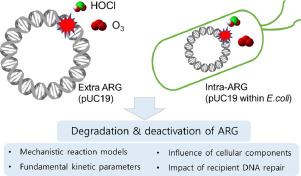Water Research ( IF 12.8 ) Pub Date : 2021-07-06 , DOI: 10.1016/j.watres.2021.117408 Younggun Yoon 1 , Huan He 2 , Michael C Dodd 2 , Yunho Lee 1

|
Degradation and deactivation kinetics of an antibiotic resistance gene (ARG) by ozone (O3) and free available chlorine (FAC) were investigated in phosphate-buffered solutions at pH 7 for O3 (in the presence of tert‑butanol), and pH 6.8 or 8.1 for FAC. We used a plasmid (pUC19)-encoded ampicillin resistance gene (ampR) in both extracellular (e-) and intracellular (i-) forms. The second-order rate constant (kO3) for degradation of 2686 base pair (bp) long e-pUC19 toward O3, which was determined by quantitative polymerase chain reaction assay, was calculated to be ~2 × 105 M−1s−1. The deactivation rate constants of e-pUC19 by O3 measured with various recipient E. coli strains were within a factor of 2 compared with the degradation rate constant for e-pUC19. The degradation/deactivation kinetics of i-pUC19 were similar to those of e-pUC19, indicating only a minor influence of cellular components on O3 reactivity toward i-pUC19. For FAC, the degradation and deactivation rates of e-pUC19 were decreased in the presence of tert‑butanol, implying involvement of direct FAC as well as some radical (e.g., •OH) reactions. The degradation rates of e-ampR segments by direct FAC reaction could be explained by a previously-reported two-step sequential reaction model, in which the rate constants increased linearly with e-ampR segment length. The deactivation rate constants of e-pUC19 during exposure to FAC were variable by a factor of up to 4.3 for the different recipient strains, revealing the role of DNA repair in the observed deactivation efficiencies. The degradation/deactivation of e-pUC19 were significantly faster at pH 6.8 than at pH 8.1 owing to pH-dependent FAC speciation variation, whereas i-pUC19 kinetics exhibited much smaller dependence on pH, demonstrating intracellular plasmid DNA reactions with FAC occurred at cytoplasmic pH (~7.5). Our results are useful for predicting and/or measuring the degradation/deactivation efficiency of plasmid-encoded ARGs by water treatment with ozonation and chlorination.
中文翻译:

暴露于臭氧和氯期间质粒编码的抗生素抗性基因的降解和失活
在 pH 7 的磷酸盐缓冲溶液中研究了臭氧 (O 3 ) 和游离有效氯 (FAC)对抗生素抗性基因 (ARG) 的降解和失活动力学,其中O 3(在叔丁醇存在下)和 pH FAC 为 6.8 或 8.1。我们在细胞外 (e-) 和细胞内 (i-) 两种形式中都使用了质粒 (pUC19) 编码的氨苄青霉素抗性基因 ( amp R )。2686 个碱基对 (bp) 长的 e-pUC19 降解为 O 3的二级速率常数 ( k O3 ),由定量聚合酶链反应测定确定,计算为 ~2 × 10 5 M − 1 s −1. 与 e-pUC19的降解速率常数相比,用各种受体大肠杆菌菌株测量的 O 3对 e-pUC19 的灭活速率常数在 2 倍以内。i-pUC19 的降解/失活动力学与 e-pUC19 的相似,表明细胞成分对i-pUC19 的O 3反应性影响很小。对于 FAC,e-pUC19 的降解和失活率在叔丁醇存在下降低,这意味着直接参与 FAC 以及一些自由基(例如,· OH)反应。e- amp R的降解率直接 FAC 反应的片段可以通过先前报道的两步顺序反应模型来解释,其中速率常数随 e- amp R线性增加段长度。e-pUC19 在暴露于 FAC 期间的失活速率常数对于不同的受体菌株可变高达 4.3,揭示了 DNA 修复在观察到的失活效率中的作用。由于 pH 依赖性 FAC 形态变化,e-pUC19 在 pH 6.8 下的降解/失活比在 pH 8.1 下显着更快,而 i-pUC19 动力学对 pH 的依赖性要小得多,表明细胞内质粒 DNA 与 FAC 的反应发生在细胞质 pH 下(~7.5)。我们的结果可用于预测和/或测量通过臭氧化和氯化水处理质粒编码的 ARG 的降解/失活效率。



























 京公网安备 11010802027423号
京公网安备 11010802027423号